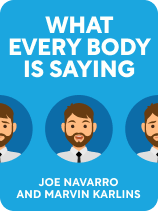

This article is an excerpt from the Shortform book guide to "What Every Body Is Saying" by Joe Navarro and Marvin Karlins. Shortform has the world's best summaries and analyses of books you should be reading.
Like this article? Sign up for a free trial here.
What can someone’s posture tell you about their psychological state? What postural cues should you pay attention to?
According to former FBI agent Joe Navarro, a person’s body posture can indicate how secure and comfortable they are feeling. Open body language and posture signal comfort and confidence. On the other hand, restricted posture indicates discomfort and insecurity.
Here’s how you can size up someone’s level of comfort based on their body posture.
Posture and Body Language
According to Joe Navarro, the author of What Every Body Is Saying, you can assess security by evaluating a person’s body language and posture. A comfortable person will move more expressively and present their body in a vulnerable and open way. On the other hand, an uncomfortable person will have restricted movements and closed body language—such as hiding, shielding themself, or preparing to escape from whatever’s causing discomfort.
(Shortform note: While posture can indicate comfort or discomfort, researchers argue that changing your posture can also change your mood. Good posture—sitting or standing with your head up and your back straight—increases testosterone and decreases stress hormones, making you feel more confident and positive. On the other hand, bad posture—sitting or standing with your head down and your back slouched—can lead to depression and lower energy, as well as increased negativity.)
Range of Movement: When we’re insecure, we naturally restrict our movements because our limbic system has activated our automatic freeze response. Navarro explains that insecure people tend to hold their arms and legs close to their bodies to avoid attracting attention. You might notice examples of this in public speaking—someone who’s uncomfortable in front of an audience will struggle to gesture emphatically and move around. They’re more likely to remain glued to the spot and struggle with voice inflection.
(Shortform note: More movement doesn’t always equal confidence. When insecure, people might display nervous jitters like shifting weight or pacing around. Some psychologists believe these repetitive movements help calm people and relieve muscle tension.)
When we feel secure, our threat responses aren’t being triggered. According to Navarro, a comfortable and confident body takes up space and often makes what he calls “gravity-defying behaviors,” such as rising onto the toes when greeting someone or raising the arms above your head to emphasize a point. For example, consider a class of students. When asked a question, students with their hands raised above their heads exude more confidence than those with bent arms at shoulder height.
(Shortform note: Researchers Jessica Tracy and David Matsumoto studied gravity-defying behaviors in Olympic medal winners, finding that both blind and sighted victors all displayed the same behaviors, such as raising their arms, expanding their chests, and tilting their heads back. Based on this, the researchers argue that behavioral displays of success and failure are biological and universal. They suggest that these behaviors stem from the biological instinct to appear bigger, convey dominance, and attract attention when confident. On the other hand, we share cringing behaviors with other animals including chimpanzees, wolves, and even crayfish to dispel conflict and signal our acceptance of someone else’s dominance.)
Posture: Navarro explains that a comfortable body has an open and vulnerable posture, whereas an uncomfortable body is more closed off. When we feel secure, nothing activates our body’s limbic instinct to protect itself. For example, if someone’s leaning back in a chair with their hands folded behind their head, they’re not conscious of themselves or the environment they’re in. Crossed legs while standing, Navarro points out, is also a sign of security because it is more vulnerable—this position leaves you more off balance. People in a heated debate, for instance, won’t stand with their feet crossed.
(Shortform note: Navarro suggests that an open posture can signal comfort, but one study also found that an open and expansive body posture also makes you more attractive to others. The study suggests that openness is nearly as important as dominance in initial attraction, as it can signal your willingness to share resources. In fact, our tendency to like people who are more willing to share goes beyond romance and holds true for all social relationships.)
Navarro adds that people often enlist their arms to protect their bodies. They might shade their eyes with a hand or cross their arms tightly across their chests. Some examples of this shielding behavior might be rearranging nearby objects to act as a barrier, clutching a protective object like a pillow, or buttoning up a shirt.
(Shortform note: In The Definitive Book of Body Language, Barbara and Allan Pease offer deeper insights into how arm blocking behaviors affect our interactions. They found that crossed arms decrease your ability to pay attention and remember the information you hear by 38%. Further, crossed arms tend to make you more critical of what someone’s saying and can often be a sign of disagreement. To break arm barriers, they advise the listener hold something, such as a book or a pencil.)

———End of Preview———
Like what you just read? Read the rest of the world's best book summary and analysis of Joe Navarro and Marvin Karlins's "What Every Body Is Saying" at Shortform.
Here's what you'll find in our full What Every Body Is Saying summary:
- A guide from a former FBI agent on how to decipher body language
- How to master the language of nonverbal communication
- How to detect when someone is lying to you and access their true thoughts






